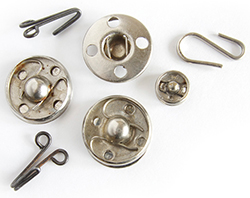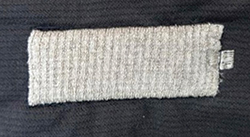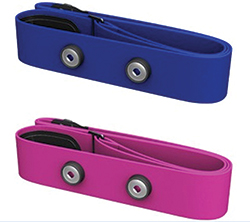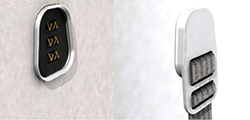In the emerging, amorphous Internet of Things (IoT), we find many expressions of technology: smart home, connected car, even the smart factory. Of all of the nascent markets in which low cost sensors and wireless connectivity are making new products and services possible, none have the potential to impact as many people in such a profound way as smart fabrics. The connected car can make your commute more efficient or productive via autonomous driving; the smart home can improve energy efficiency dramatically and illuminate new ways of improving our use of resources and time; the smart factory can enable faster, more efficient and safer work environments that in turn produce more advanced products at steadily declining costs. Smart fabrics, however, offer the opportunity to measure, analyze and inform the trajectory of our lives.
Why Smart Textiles?
The IoT and ‘smart’ product movements are simply about enabling the collection and transmission of data to the cloud without human intervention. Textiles, in particular, are a fantastic medium for the integration of bio-metric sensors. There is good logic behind this as advances in flexible and printed electronics have led to the widespread availability of new conductors that are well suited to flexible, stretchable substrates like textiles. When you think about the opportunity for increasing understanding of ourselves and our physiology, textiles are the perfect medium. We are not just in contact with textiles most of every day — we are in contact with textiles most of our lives. There is no better vehicle for unobtrusive sensing of heart rate, breathing, muscle activity — even temperature and motion tracking.

Figure 1 Button snap and constituent components.
Standards
Wearables in general have a challenge when it comes to standards. While the existence of standard communication protocols like Bluetooth, Wi-Fi, Zigbee and USB have enabled very low cost components and increasingly miniaturized solutions, the connectivity and sensing between the product and its target — us — has endured a confusing array of possible paths. For example, while so many wristbands and smartwatches today are measuring heart rate via photoplethysmography, there is no standard to which any particular product can be certified for this measurement. It’s the same for step tracking and motion sensing — each device manufacturer finds a different way of measuring these actions.
If wearables are bad with standards, smart fabrics are worse. While nearly every piece of smart clothing available today offers heart rate monitoring via ECG, there is no standard to which all of the sensors are measured. Additionally, this is not a piece of hardware we are talking about — it’s typically a piece of athletic apparel, and standards in the apparel industry are not at all like standards in electronics or software.
Connectors
Mention ‘wearables’ to someone and they’re likely to think of a wristband like the Jawbone Up, Fitbit Charge or even the Apple Watch. Each of these products uses a proprietary external connector primarily for recharging the device’s battery. Consumer experience with mobile phones has trained us to keep charging cables within reach — it is not unusual to recharge your phone while in the car or at the coffee shop. A wearable, however, has different expectations. There is no use case for charging something you wear — even more so when it is an article of clothing.

Figure 2 Hexoskin smart apparel.
Often when designing a particular connector into an application or product, we are forced to deal with constraints that the available space forces on us. That is, we have a particular volume we can fill in a particular area of the device. Thanks to standards like USB, we know roughly how much space our plug or receptacle is going to fill. There are choices around how the connector is mounted or sealed within the device, and it’s these details that normally comprise the bulk of the task of designing in the connector. In wearable devices and smart textiles however, this challenge is turned on its head.
Smart textiles typically rely on a connection to electronics rather than integration with electronics. While LEDs have been placed into textiles for some time, they stand alone as one of the few electronic components that have undergone direct integration. Using conductive elements in a textile for transmission or sensing while leaving discrete electronic components off-board (outside the textile) is much more common. Most of the conductors are in the form of silver threads that may vary in conductivity considerably depending on the particular thread but have a resistance of about 80 ohms per foot. Conductive polymers and pastes are also beginning to see wide use and have similar conductivity as the threads. In some cases, thin gauge copper wire is used as a sensor to measure changes in size or shape, expansion or contraction. In very few cases, there is also the need to deliver power, again via copper wires. With this variety in conductors, the major requirements of the connector are not electrical — they are physical. While the application requirements may differ significantly from one smart textile product to another, nearly all developers agree that the connection should be invisible, flexible and washable.
Invisibility
When we speak of invisibility in textile connectors, we’re really pointing toward the need for a solution that is unobtrusive. Because many smart textile products are garments — dresses, shirts, shorts — we need to consider the user carefully. No one wants a big, bulky connector on his or her shirt, especially if it’s a tight fitting workout shirt. Today, many of the smart textile products use a simple button snap (see Figure 1) as a connector.

Figure 3 Conductive thread electrode.
They provide a robust connection between the conductor and the electronics box, and they are a known quantity to textile and apparel manufacturers — no special training or tools required. They are, however, a single contact only. If you need multiple or high frequency connections, the solution can quickly become unwieldy.
Flexibility
In electronics, we are used to working with hard things: PCBs, semiconductors, displays, components of all types that get reflowed onto a board and often placed inside a hard enclosure, whether it is a cell phone, tablet or rack-mounted server. In smart textiles, it is the complete opposite — everything is soft and pliable. Connectors that had been designed to bridge circuits between two hard environments simply fall short when trying to bridge the hard-to-soft transition between textiles and electronics. What developers have been asking for is a connector system that is physically flexible and can move with the contours of the textile itself when placed on a body or in its final application. The connector should not inhibit the flow or drape of a textile. Flexibility has a second meaning — adaptability. The connector must be physically flexible, but it should also be designed to meet a wide range of uses with a textile application. The ideal connector would be able to handle power, signal and RF within a minimized structure that meets the earlier requirement of being invisible.

Figure 4 Chest straps with button snaps.
Washability
Perhaps the most difficult requirement to meet is washability. It is amusing that while the connector industry has matured to provide all types of connection systems for use in deep space, in the depths of the oceans or even inside the human body, we have so few options for the washing machine. The agitation that a connector must endure during a typical wash cycle is very significant and, as a result, the strain relief between the connector and the conductor needs to be carefully considered. Additionally, we want to avoid developing connectors with small cavities that could fill with water or detergent and complicate successful connections after the wash cycle. Encapsulation of connection joints can help protect them but complicates the application by making a permanent connection when most designers are in favor of temporary, removable connections.
Innovating in a Mature Industry
Underneath the three requirements of invisibility, flexibility and washability is the implied ease-of-use. While exotic, miniaturized connector structures based on flexible electronics and conductive plastics are exciting and offer new ways of solving the connection problem, we must remember that the apparel industry has a very mature, well-established supply chain. In many cases their manufacturing and assembly techniques have not undergone significant change in decades. If we introduce a product that requires tools or skills that are outside the norm, we are unlikely to succeed. There are no garment manufacturers training their people in soldering techniques no matter how good or revolutionary the connector may be. It is critical that connectors designed for textile applications also work within the constraints of the textile assembly ecosystem. Laser cutting, heat presses, stitching, and perhaps ultrasonic welding all provide viable paths towards connector assembly.

Figure 5 Hexoskin’s proprietary connector.
Application: Smart Shirt
Let us consider a smart athletic shirt to see how all these components come together. There are several companies producing versions of these today, and they are gaining some traction with both professional athletes and the early adaptors in the gym. Smart shirts are typically a snug-fitting compression garment intended to be in close contact with the skin. An example is Montreal-based Hexoskin, producing products for athletes and astronauts since 2006. Their shirt is an example of the state-of-the-art in smart athletic wear (see Figure 2).
All the smart athletic shirts today offer heart rate monitoring via electrocardiography. For sensors, the shirts use conductive threads that function as electrodes for the collection of ECG data. As mentioned earlier, these threads are somewhat resistive, but high conductivity is not necessary for sensing heart rate. These types of ‘dry’ sensors can be somewhat troublesome, in that they cannot get a good signal from the skin through body hair or without sufficient sweat between the thread and the skin to aid conductivity. Carbon nanotube based threads are being considered for these applications, and in some cases, may offer significant advantages due to their higher conductivity, while still maintaining a pliable, thread-like structure. Whichever element is chosen as the conductor for ECG, the requirements for the connector remain basically the same. At least two electrodes are created in the garment by either knitting with the conductive thread (see Figure 3) or embroidering an already-built conductive polymer electrode and transmission line into place.

The transmission lines are most often terminated against a button snap as described earlier. No special treatment is required; the compressive force of the button snap assembly provides adequate electrical contact with the thread. Most of the chest straps available today use these snaps as the connection point to the electronics (see Figure 4).
If we rely on button snaps as the connector, we are limited in how many points of contact we can have while keeping the small form factor or ‘invisibility’ that developers want. This means fewer lines of sensing, fewer lines for power and fewer opportunities to add the additional functionalities that would create so much value for users.

Figure 6 Ohmatex’s textile connector.
Hexoskin worked with the ecosystem of electronics suppliers to develop a connector for their shirt but ultimately elected to design and build it themselves (see Figure 5). The resulting connector fits their application perfectly, while achieving cost targets they can live with. Their unique connector is at the end of a textile cable that is integrated into the shirt — this allows the user to connect to the electronic device and place it conveniently into a pocket while working out.
Danish entrepreneur Christian Dalsgaard launched Ohmatex in 2004, specifically to solve the connection and integration issues that he saw around smart textiles. They have developed a line of connectors for textile applications that are well suited for medical, military and aerospace applications — opportunities where the quality and durability of the connector is mission critical, and size is a secondary concern (see Figure 6).
Smart textiles have been around for several years but are gaining momentum as one expression of the IoT and as consumer interest in wearable technologies increases. While many inventive startups have emerged to create new garments and other soft goods that include sensing and interactivity via flexible conductors there still remains a significant challenge in how we connect the hard world of electronics with the soft world of textiles. Clearly, there is an exciting opportunity here for inventive engineers and designers. If the shoe fits.
